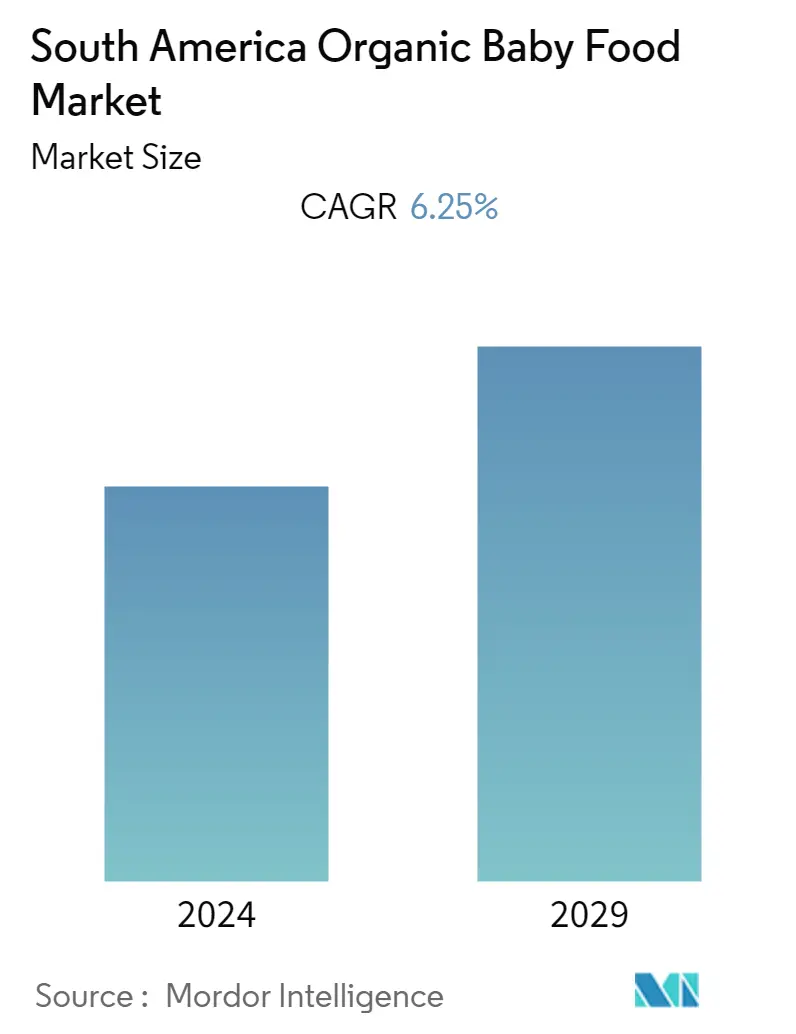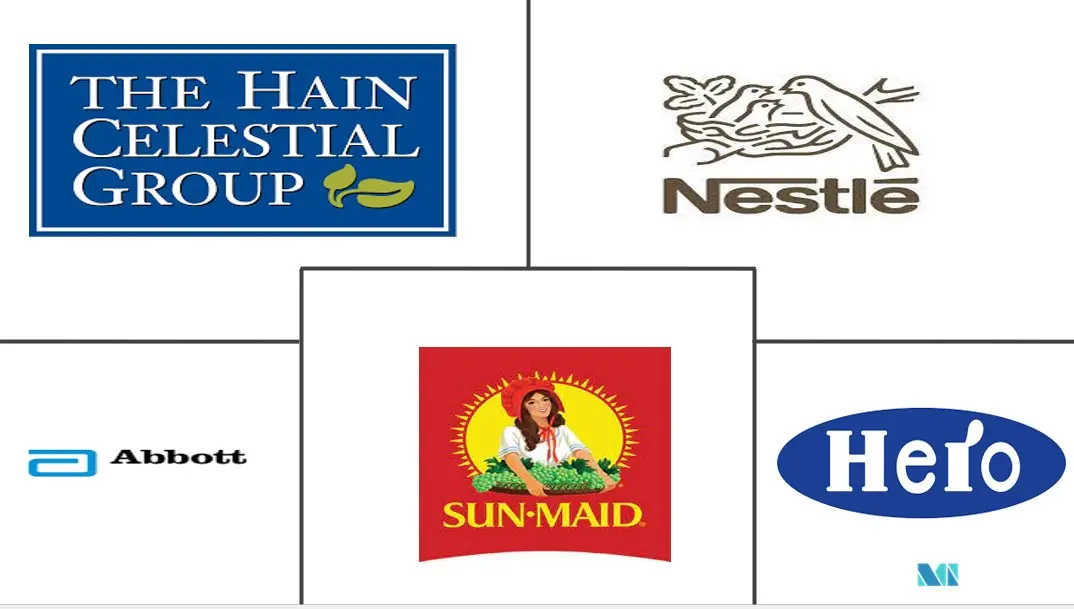Market Size of South America Organic Baby Food Industry

| Study Period | 2019 - 2029 |
| Base Year For Estimation | 2023 |
| Forecast Data Period | 2024 - 2029 |
| Historical Data Period | 2019 - 2022 |
| CAGR | 6.25 % |
| Market Concentration | High |
Major Players
*Disclaimer: Major Players sorted in no particular order |
South America Organic Baby Food Market Analysis
South America Organic Baby Food market is projected to register a CAGR of 6.25% during the forecast period, 2022-2027.
Post COVID 19, some of the major issues have been raised in the overall food and beverage industry, after the pandemic, people are consuming healthy diet for protecting themselves and their babies with an aim to improve their immune system fight against COVID-19. Therefore, the demand of organic baby food has been increased across the region.
As people look for healthier diets and lifestyle options, organic products are becoming more and more popular. As a result, baby food products made with natural and organic components are quickly gaining popularity across the region. The market's growth will be largely fueled by the growing penetration rate of wide variety of products in retail stores and online marketplaces. Additionally, the increased number of working women had play a vital big role in the sector's expansion, making prepared organic baby food one of the fastest-growing segments.
South America Organic Baby Food Industry Segmentation
Organic baby foods are grown or processed without synthetic fertilizers or pesticides. The organic baby food market is segmented by product type, distribution channel, and geography. By product type, the segmentation includes prepared baby food, dried baby food, and milk formula. By distribution channel, the market is segmented into supermarkets/hypermarkets, convenience stores, online retail stores, and other distribution channels. By geography, the market is segmented into Brazil, Argentina, and Rest of South America. For each segment, the market sizing and forecasts are done in value terms of USD million.
| By Product Type | |
| Milk Formula | |
| Prepared Baby Food | |
| Dried Baby Food |
| By Distribution Channel | |
| Supermarkets/Hypermarkets | |
| Convenience/Grocery Stores | |
| Online Retail Stores | |
| Others |
| By Geography | |
| Brazil | |
| Argentina | |
| Rest of South America |
South America Organic Baby Food Market Size Summary
The South America organic baby food market is experiencing significant growth, driven by a shift in consumer preferences towards healthier diets and lifestyles. This trend has been amplified post-COVID-19, as parents increasingly seek to enhance their and their babies' immune systems through nutritious food choices. The popularity of organic baby food is rising, fueled by the growing availability of these products in retail and online marketplaces. The market is further bolstered by the increasing number of working women, who prefer convenient, prepared organic baby food options that offer essential nutrients for rapid infant development. Innovations such as high-pressure processing (HPP) are also contributing to market expansion, with products being offered in convenient formats like on-the-go pouches and flexible tubs.
The market landscape is highly competitive, with major players like Nestlé S.A., The Hain Celestial Group, Inc., and Abbott Laboratories leading the charge. These companies are focusing on product innovation to cater to changing consumer tastes and preferences, offering organic baby foods with added health benefits and certifications to build consumer trust. Despite the competitive nature of the market, challenges such as declining birth rates in countries like Brazil pose potential hurdles. However, the overall market continues to grow, supported by increasing awareness of the importance of nutrition in infant development and the demand for organic, health-focused baby food options.
South America Organic Baby Food Market Size - Table of Contents
-
1. MARKET DYNAMICS
-
1.1 Market Drivers
-
1.2 Market Restraints
-
1.3 Porter's Five Force Analysis
-
1.3.1 Threat of New Entrants
-
1.3.2 Bargaining Power of Buyers/Consumers
-
1.3.3 Bargaining Power of Suppliers
-
1.3.4 Threat of Substitute Products
-
1.3.5 Intensity of Competitive Rivalry
-
-
-
2. MARKET SEGMENTATION
-
2.1 By Product Type
-
2.1.1 Milk Formula
-
2.1.2 Prepared Baby Food
-
2.1.3 Dried Baby Food
-
-
2.2 By Distribution Channel
-
2.2.1 Supermarkets/Hypermarkets
-
2.2.2 Convenience/Grocery Stores
-
2.2.3 Online Retail Stores
-
2.2.4 Others
-
-
2.3 By Geography
-
2.3.1 Brazil
-
2.3.2 Argentina
-
2.3.3 Rest of South America
-
-
South America Organic Baby Food Market Size FAQs
What is the current South America Organic Baby Food Market size?
The South America Organic Baby Food Market is projected to register a CAGR of 6.25% during the forecast period (2024-2029)
Who are the key players in South America Organic Baby Food Market?
The Hain Celestial Group, Inc , Nestle SA, Abbott Laboratories , The Hero Group and Sun-Maid Growers of California are the major companies operating in the South America Organic Baby Food Market.

